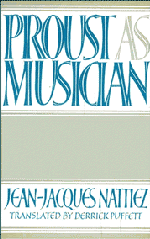Book contents
- Frontmatter
- Contents
- Preface to the English edition
- Translator's note
- 1 Introduction: Beyond the ‘little phrase’
- 2 Parsifal as redemptive model for the redemptive work
- 3 Music as redemptive model for literature
- 4 From Vinteuil to Schopenhauer
- 5 In conclusion: Quest for the essence and denial of the origin
- Appendix: Passages from A la recherche translated in the text
- Notes
- References
- Index
1 - Introduction: Beyond the ‘little phrase’
Published online by Cambridge University Press: 27 October 2009
- Frontmatter
- Contents
- Preface to the English edition
- Translator's note
- 1 Introduction: Beyond the ‘little phrase’
- 2 Parsifal as redemptive model for the redemptive work
- 3 Music as redemptive model for literature
- 4 From Vinteuil to Schopenhauer
- 5 In conclusion: Quest for the essence and denial of the origin
- Appendix: Passages from A la recherche translated in the text
- Notes
- References
- Index
Summary
Yet another contribution on the special relationship between Proust and music, one might think. This is, in fact, a topic of research and reflection which returns with pendulum-like regularity in Proust criticism. It is certainly not my ambition to present a synthesis of all that has been written and all that could be written on the subject, but it seemed to me in the light of recent information that a fresh look at the question might be justified. I shall start by surveying the work of my predecessors, in order to define the aims and limits of the present essay.
According to Ingarden, literature constructs a quasi-world. This is particularly true of Proust, whose A la recherche reveals a complex, complete and self-contained universe. Like all phenomena of the world, music has its place in it, a special place, as we shall see, alongside society, the emotions, literature and painting. Hence we can study the musical universe of Proust the man (Piroué 1960: Part I, ‘La Musique dans la vie de Proust’) – drawing on biographies, memoirs, correspondence (Mayer 1978) – and of his work: Georges Matoré and Irèene Mecz (1972: 30), using the index in the first Pléiade edition, have identified the names of 170 writers, eighty painters and forty musicians. Wagner comes top of the list with thirty-five mentions, Beethoven second with twenty-five; Debussy appears thirteen times. These figures are probably conservative, for the index does not include adjectives (‘Wagnerian’), the titles of works or numbers (Lohengrin, the ‘Song to the Evening Star’) are not listed, and the text contains allusions to specific works or composers that have to be decoded.
- Type
- Chapter
- Information
- Proust as Musician , pp. 1 - 11Publisher: Cambridge University PressPrint publication year: 1989

